
Monarda in part shade garden with Persicaria amplexicalulis.
Monarda, a North American native, is one of the workhorses of the perennial garden as well as the herb garden. Its leaves are aromatic and somewhat citrusy and historically have been used in teas by the Indians for pleasure and for medicinal purposes. The flowers are tangy and can be used in salads, floated in punch bowls or utilized as garnishes. Monarda was first identified in 1571 by Nicholar Monardes, a Spanish botanist who authored the first book on medicinal flora of North America.

A bee deep into a Monarda bloom, seeking nectar.
The four-sided stems automatically identify Monarda as a member of the mint family. The flowers are surrounded with colored bracts and carried in terminal, whorled clusters. Beebalm is aptly named because it provides ample nectar for bees. As we have become aware, bees, as pollinators, are an essential cog in plant production. Monarda is also an attractor of butterflies and hummingbirds.
This perennial will grow best in full sun or half a day of sun and average to moist soil. Because it is a rhizomatous perennial, it will spread faster with more moisture and be better behaved with less. Allan Armitage maintains, however, that letting the soil dry out is a contributing factor to powdery mildew. Thinning the stems contributes to better air circulation and, perhaps, better resistance to the mildew.
I have found that plants disfigured by powdery mildew benefit from a “haircut” as soon as the first flush of bloom is over. Quite often, the new foliage is clean and rebloom occurs within a month. Deadheading encourages rebloom as well as bushier plants because they tend to branch at the juncture where they have been pruned. Division every two to three years will contribute to its vigor but also help control its spread.
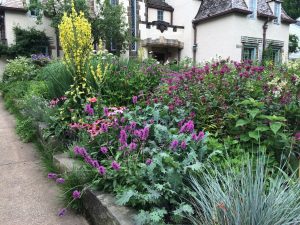
Monarda ‘On Parade’ (left) and ‘Dark Ponticum’ (right) with Verbascum, Flowering Kale, Stachys monieri ‘Hummelo, and Echinacea ‘Pixie Meadowbrite’ in Bobbie’s garden.
The best-known Beebalm species is Monarda didyma of which there are several cultivars. Even the most mildew-resistant cultivars such as ‘Jacob Kline’, ‘Marshall’s Pink’, ‘Raspberry Wine’, ‘Purple Rooster’, ‘Dark Ponticum’, and ‘On Parade’ still are not totally resistant.
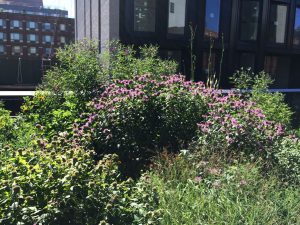
Grouping of Monarda fistulosa at The High Line
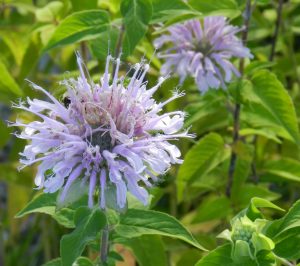
Closeup of Monarda fistulosa
These cultivars do grow taller – four feet instead of two to three feet – than some of the older cultivars because most of them are crosses with M.fistulosa (Wild Bergamot) which does not get mildew. However, subsequent deadheading and pruning does shorten them.
Many of the native species, such as Monarda bradburiana and punctata do not get powdery mildew. Their foliage looks a bit different as do the bracts which occur in stages up the stem. However, they are available only from specialty nurseries.
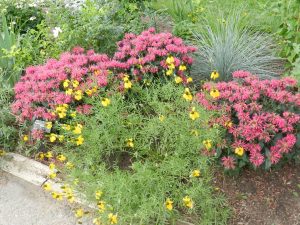
Monarda ‘Balmy Rose’ with Ratibida
There are now several dwarf cultivars that are mildew-resistant, including the Balmy series. My problem with them is that deadheading them is back breaking.
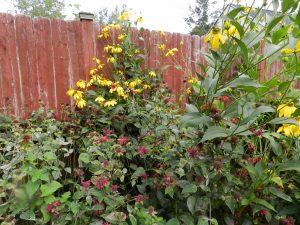
Colorful back yard garden with painted fence that makes an excellent background of this red and yellow combination of red Monarda and Rudbeckia laciniata ‘Herbstsonne’.
Monarda is a valuable component of the perennial garden because of its long period of bloom, July to October, as well as its unusual flower type. Use a pink cultivar with Leucanthemum superbum ‘Becky’ or ‘Daisy Duke’ (which is a bit shorter) and Coreopsis verticillata ‘Moonbeam’. All three will bloom from July to September and fight it out for territorial rights. Or try ‘Jacob Kline’, the best red, with Rudbeckia laciniata ‘Herbstsonne’ and Phlox paniculata ‘David’ for a different color combination. Throw in a few ornamental grasses as well and you have both color and texture.
Treat yourself and the bees to Beebalm.


0 Comments